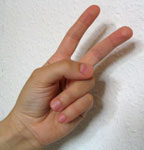Radical 7
| 二 | ||
|---|---|---|
| 6 ⼅ ◄ | 7th | ► ⼇ 8 |
| Pinyin : | he | |
| Zhuyin : | ㄦ ˋ | |
| Hiragana : | に ni | |
| Kanji : | 二 ni (= two) | |
| Hangul : | 두 you (둘) | |
| Sinocorean : | 이 i | |
| Codepoint : | U + 4E8C |
|
| Stroke sequence : |
|
|
The radical 7 meaning “ two ” is one of 23 traditional radicals in Chinese writing with two strokes.
With 14 character combinations in Mathews' Chinese-English Dictionary , it is relatively rare in the dictionary. In the Kangxi dictionary there are also only 29 characters that can be found under this radical .
Sometimes this radical is easy to recognize in the sign as in 些 (= some), but sometimes, when it is torn apart, not as easily as in 五 (= five).
The pictogram shows two lines that can be interpreted in different ways: as a sign in the sand, as notches on a piece of wood or as lines of numbering.
There is a so-called capitalization 贰 for this symbol , for example on checks, to prevent forgery in 三 (three).
The sign is similar to the katakana sign ニ "ni".
Character combinations ruled by radical 7
| Strokes | character |
|---|---|
| + 0 | 二
|
| + 1 | 亍 于 亏 亐
|
| + 2 | 云 互 亓 五 井 亖
|
| + 3 | 亗
|
| + 4 | 亘 亙 亚
|
| + 5 | 些 亜
|
| + 6 | 亝 亞 亟 |
In the Unicode block Kangxi radicals , radical 7 is coded under the code point number 12.038 (U + 2F06).
literature
- Edoardo Fazzioli : Painted Words. 214 Chinese characters - from picture to concept . Marixverlag, Wiesbaden 2004, ISBN 3-937715-34-7 , p. 237 .
- For detailed references, see List of Traditional Radicals: Literature
Web links
- Xiù cai.oai.de (PDF; 1.72 MB) Explanation of Radikal 7 on page 7

